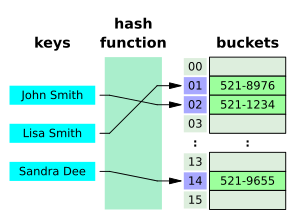Hash table facts for kids
Quick facts for kids Hash table |
||||||||||||||||||||||||
|---|---|---|---|---|---|---|---|---|---|---|---|---|---|---|---|---|---|---|---|---|---|---|---|---|
| Type | Unsorted associative array | |||||||||||||||||||||||
| Invented | 1953 | |||||||||||||||||||||||
|
||||||||||||||||||||||||
A hash table is a clever way computers store information. Imagine you have a lot of items, and you want to find them super fast. A hash table helps you do just that! In computer science, these tools for keeping track of information, or data, are called data structures.
A hash table uses a special rule, called a hash function, to decide exactly where each piece of data should go. Every piece of information has a unique name, which we call a key. For example, a key could be a person's name. This key is linked to a piece of data, called a value, like that person's phone number.
The data is stored in something called an array. Think of an array as a long row of numbered boxes or buckets. Each box has a number, starting from 0 and counting up.
How Does a Hash Table Work?
The main idea behind a hash table is to figure out which numbered box to put data into, just by looking at its name (the key). This means you can always find information quickly if you know its name, no matter how many boxes are filled.
The hash table uses a hash function to do this. The hash function takes the key (like a person's name) and turns it into a number. This number tells the hash table exactly which box in the array to use for that data.
Why Are Hash Tables Useful?
One of the best things about a good hash table is its speed. It can almost always find information at the same speed, no matter how much data you put in. Many hash tables also let you add new key/value pairs (a name and its data) and remove them just as quickly.
Because of this speed, hash tables are often much faster at finding information than other tools. These include things like search trees or other ways of looking up data.
You can find hash tables used in many different computer programs. They are very common for things like associative arrays (which link keys to values), databases, caches (which store frequently used data), and sets (collections of unique items).
Images for kids
See also
 In Spanish: Tabla hash para niños
In Spanish: Tabla hash para niños



